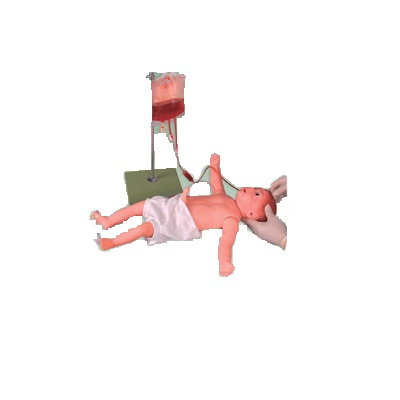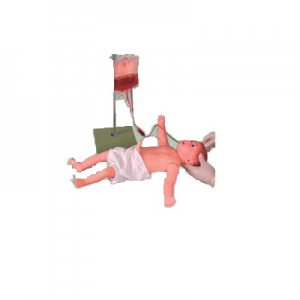Venipuncture in infants is a complex and delicate procedure, especially in clinical emergency Settings, where correct and rapid venipuncture is essential. However, due to the relatively small and fragile blood vessels of infants, how to successfully complete the venipuncture operation in a stressful emergency environment has become a great challenge for many medical personnel. In recent years, infant systemic venipentesis model has gradually entered the clinical training system. Can it provide effective support for medical staff? This paper will discuss the function of this model and its application value in first aid training.
The challenges of systemic venipuncture in infants
Venipuncture in infants often presents a number of challenges. First of all, because the baby's veins are thin, deep and soft, it is more difficult to Pierce. Secondly, the baby's skin is thin and vulnerable, and a slight mistake in the puncture process may cause blood vessel penetration or tissue damage, leading to pain or complications. In addition, in emergency situations, medical personnel need to complete the puncture quickly and accurately to ensure the timely delivery of drugs or liquids, which puts extremely high requirements on operational skills and psychological quality.
In this context, the emergence of simulation training tools is particularly important, and the infant whole body venipunction model is an advanced training tool developed to deal with this challenge.

The role of systemic venipuncture model in infants
The whole body venipentesis model of infants provides a safe and repeatable training environment for medical staff by highly reconstructing the body shape, skin texture and blood vessel distribution of infants. The biggest advantage of the model is its authenticity and real-time feedback function, which can help students gradually master the correct steps and techniques of venipuncture without actual risk.
Specifically, the infant systemic venipunction model has the following functions:
1. Accurate training simulation
The model simulates the venous structure of the whole body of the baby, including multiple puncture points such as the upper and lower limbs, and the simulated vascular feedback is also very real, which can enable the medical staff to accurately grasp the depth and Angle of the puncture and improve its operation accuracy.
2. Real-time feedback and evaluation
The model has built-in sensors that can record the movement during the puncture process in real time, including the Angle and depth of the needle. Through this feedback, students are able to identify and correct errors in a timely manner, further improving operational proficiency.
3. Strengthen emergency response capacity
In the actual clinical emergency, doctors often need to complete the operation in a very short time, and any mistake will affect the treatment effect. The infant venipentesis model can simulate different emergency situations, so that students can train under pressure and improve their emergency response ability in high-pressure environments.
4. Reduce risks in actual operation
Although infant venipuncture is a common medical procedure, errors in the procedure can cause unnecessary injuries to newborns. By repeatedly training on simulation models, healthcare professionals can hone their skills and gain experience without harming real patients.
The application value of clinical first aid training
The application of infant systemic venipunction model in clinical first aid training is especially reflected in the following aspects:
1. Improvement of training efficiency
Through simulation training, students can quickly master every link from preparation, disinfection, puncture to observation, avoiding making beginner's mistakes in clinical practice. The highly simulated experience provided by the model can shorten the learning cycle from theoretical knowledge to practical operation.
2. Standardization and individuation of training
In traditional training, it is often difficult for teachers to give personalized guidance according to the needs of each student. Through the infant whole body venipentesis model, students can practice according to their own progress, and teachers can grasp the training situation of each student more accurately, and then provide more targeted feedback to improve the standardization and personalized level of training.
3. Reduce the rate of first aid errors
A study conducted by a medical education organization showed that medical staff who used the infant model of whole body venipuncesis had an error rate of emergency procedures about 25% lower than those who did not use the model. This data shows that simulation training can effectively reduce errors in actual operation and improve the success rate of first aid.
4. Simulate emergency situations
In the process of clinical first aid, emergency situations often come out of the blue, and medical staff must make quick and accurate decisions. The infant venipentesis model can simulate a variety of complex situations (such as a baby in a state of suffocation or in need of rapid fluid rehydration), allowing medical staff to train their ability to respond to emergencies in a safe environment.
conclusion
As an advanced clinical training tool, infantile venipunction model can help medical staff to accumulate experience and improve operational skills in a simulated environment, especially in first aid training. Through its highly simulated training scenarios and real-time feedback capabilities, the model helps students master key venipunction skills and improve their resilience in clinical emergency care. In addition, repeated training using such models can effectively reduce the error rate in actual operation and ensure the safety of newborns. With the continuous progress of technology, the infant venipentesis model will provide efficient, safe and accurate training support for more medical personnel, and then promote the standardization and standardization of first aid training.

